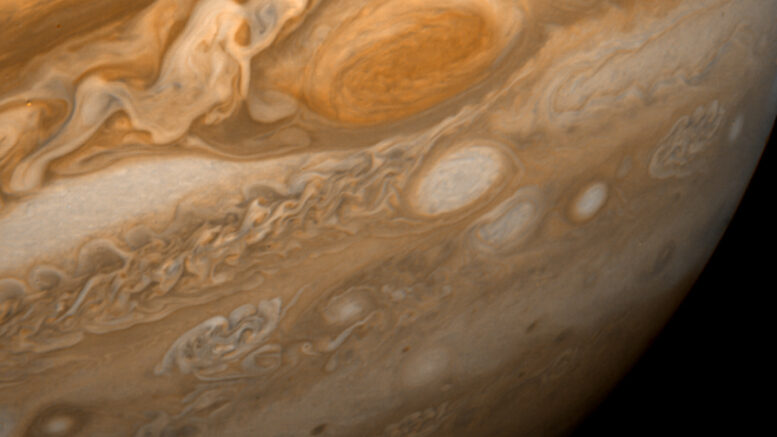Probably Jupiter’s most famous and recognizable feature is the Great Red Spot! So lets take some time today to talk about the history of this amazing feature!
Located at 22 degrees south of Jupiter’s equator, it has been continuously observed since 1878.[1] There is some speculation that pre-1878 observations of Jupiter had seen this same storm from 1665 to 1713. If seen as early as 1665, the red spot has been visible for at least 360 years.[2]
the first sighting of the Great Red Spot is often credited to Robert Hooke, who described a spot on the planet in May 1664. However, it is likely that Hooke’s spot was in another belt altogether (the North Equatorial Belt, as opposed to the current Great Red Spot’s location in the South Equatorial Belt). Much more convincing is Giovanni Cassini’s description of a “permanent spot” the following year.[3] With fluctuations in visibility, Cassini’s spot was observed from 1665 to 1713, but the 118-year observational gap makes the identity of the two spots inconclusive. The older spot’s shorter observational history and slower motion than the modern spot makes it difficult to conclude that they are the same.[4]
In the 21st century, the Great Red Spot was seen to be shrinking in size. At the start of 2004, it had approximately half the longitudinal extent it had a century ago, when it reached a size of 40,000 km (25,000 mi), about three times the diameter of Earth. At the present rate of reduction, it would become circular by 2040. It is not known how long the spot will last, or whether the change is a result of normal fluctuations.[5] In 2019, the Great Red Spot began “flaking” at its edge, with fragments of the storm breaking off and dissipating.[6]
It is not known what causes the reddish color. Hypotheses supported by laboratory experiments suppose that the color may be caused by chemical products created from the solar ultraviolet irradiation of ammonium hydrosulfide and the organic compound acetylene, which produces a reddish material, most likely complex organic compounds called tholins.[7] The high altitude of the compounds may also contribute to the color.]
It rotates anti-clockwise, with a period of about six Earth days[9] or fourteen Jovian days. With a width measuring 16,350 km, or 10,160 miles, as measured in mid-2017, Jupiter’s Great Red Spot is 1.3 times the diameter of Earth.[10] The cloud-tops of this storm are about 8 km (5.0 mi) above the surrounding cloud-tops.
Infrared data have long indicated that the Great Red Spot is colder (and thus, higher in altitude) than most of the other clouds on the planet.[11] The upper atmosphere above the storm, however, has substantially higher temperatures than the rest of the planet. Acoustic (sound) waves rising from the turbulence of the storm below have been proposed as an explanation for the heating of this region.[12]
In terms of seeing the Red Spot with a telescope, generally a magnification of 30-50x the aperture of your telescope, in inches, works well on nights of average seeing. So if you have a 4-inch telescope, try 120x to 200x. If you have razor sharp optics and steady sky, you can get away with even more magnification to view the red spot.
Check out the Planetary Bodies Category for previous and upcoming articles on the solar system planets.
Sources
[1] = Chang, Kenneth (2017-12-13). “The Great Red Spot Descends Deep Into Jupiter”. The New York Times.
[2] = “The Solar System – The Planet Jupiter – The Great Red Spot”. Dept. Physics & Astronomy – University of Tennessee. Archived from the original on 2004-06-10.
[3] = Rogers, John H. (1995). The Giant Planet Jupiter. p6. Cambridge: Cambridge University Press. ISBN 978-0521410083.
[4] = Rogers, John H. (1995). The Giant Planet Jupiter. p 188. Cambridge: Cambridge University Press. ISBN 978-0521410083.
[5] Beatty, J. Kelly (2002). “Jupiter’s Shrinking Red Spot”. Sky and Telescope. 103 (4): 24. Retrieved 2007-06-21.
[6] = Paul Scott Anderson (10 June 2019). “Is Jupiter’s Great Red Spot disintegrating?”. EarthSky.
[7] = Loeffer, Mark J.; Hudson, Reggie L. (2018). “Coloring Jupiter’s clouds: Radiolysis of ammonium hydrosulfide (NH4SH)”. Icarus. 302: 418–425. doi:10.1016/j.icarus.2017.10.041.
[8] = “What makes Jupiter’s Red Spot red?”. EarthSky. 2014-11-11.
[9] = Smith, B. A.; et al. (1979). “The Jupiter system through the eyes of Voyager 1”. Science. (4396): 951–957, 960–972. Bibcode:1979Sci…204..951S. doi:10.1126/science.204.4396.951. PMID 17800430.
[10] = Perez, Martin (2017-07-12). “NASA’s Juno Spacecraft Spots Jupiter’s Great Red Spot”. NASA. Retrieved 2017-07-16.
[11] = Rogers, John H. (1995). The Giant Planet Jupiter. p191. Cambridge: Cambridge University Press. ISBN 978-0521410083.
[12] = O’Donoghue, J.; Moore, L.; Stallard, T. S.; Melin, H. (27 July 2016). “Heating of Jupiter’s upper atmosphere above the Great Red Spot”. Nature. 536 (7615): 190–192. doi:10.1038/nature18940. hdl:2381/38554

Be the first to comment on "Jupiter’s Great Red Spot"